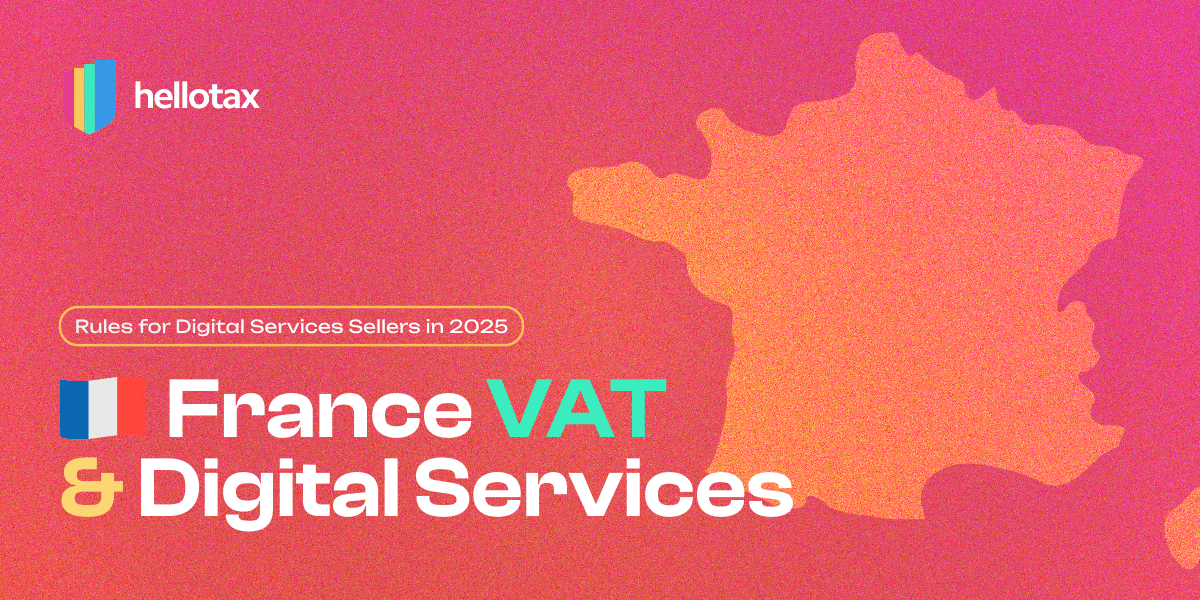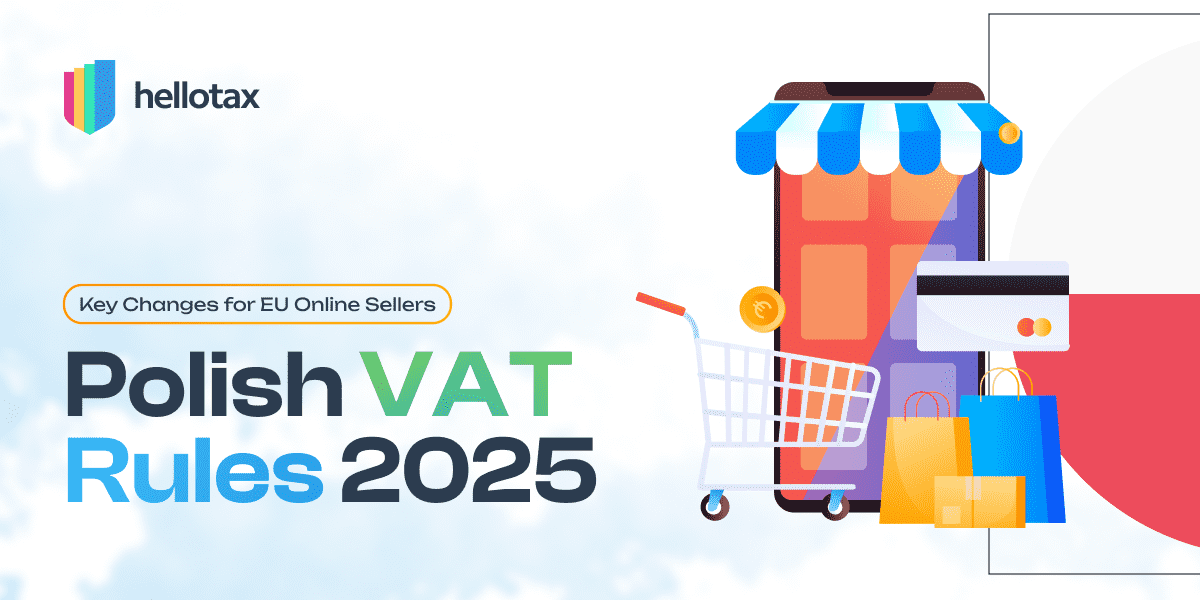The “One Stop Shop” regulation is part of the EU VAT reform for e-commerce from July 2021 and leads to a uniform EU VAT return, without individual delivery thresholds. Here you can find out what changes for online sellers, which adjustments to the VAT regulations were made, and how the OSS works.
Dominik Larcher
Last Updated on 10 July 2025
Until July 2021, the Mini One Stop Shop (MOSS) was an electronic system allowing service providers supplying telecommunications, broadcasting, and electronic (TBE) services to consumers in the EU to declare and pay VAT due in all EU Member States in one single Member State.
From 1st July 2021, the MOSS scheme was extended to all business-to-consumer (B2C) services taking place in EU Member States where the supplier is not established (storing goods). This new One Stop Shop (OSS) will also apply to all distance sales of goods within the EU and to certain domestic supplies of goods facilitated by electronic interfaces under certain conditions. What is more, another new scheme will be created for the declaration and payment of VAT on distance sales of low-value goods imported from outside the EU, called the Import One Stop Shop (IOSS).
What are the key benefits of OSS (One Stop Shop)?
We are told that the OSS is designed to simplify the European VAT return filing system for businesses, and indeed on the long term that most likely would be the case. In the short term, though, while the tax offices are setting up the registration process and businesses are getting registered and learning about the new laws, it may feel a little bit more complicated for you.
These are the main benefits of OSS:
- One way it would simplify things for you in the future would be by eliminating the need for VAT registration in EU countries you sell, but do NOT store goods in.
- Different countries’ distance thresholds will be replaced by one EU-wide threshold of 10,000 euros.
- Another simplification is being able to file one OSS return that covers all of your EU VAT cross-border obligations for B2C sales. So this is regarding cross-border, business-to-consumer only – you will still need to file your normal separate VAT returns in your home country and in countries where you store goods.
- The OSS file VAT return to your home country, in case of EU sellers – or nominated country, in case of Non-EU sellers – will be processed by the country home office and money due to other EU countries (remember, just for cross border B2C sales) will be sent to them by the tax office.
For example, companies storing goods in their home country and selling into 5-6 other EU countries without storage there will now only have to submit one home VAT return and one OSS VAT return per period. A payment for each return will be required.
How to register for OSS (One Stop Shop)?
If you wanted to use the OSS from July 1st, 2021, or the 3rd quarter of the year, you had to sign up for OSS by June 30th at the latest. Use of the OSS from Q4 or October 1st was possible with registration by the end of September at the latest. In principle and in the future, the following applies: Registration must be completed by the end of a quarter in order to be able to use the One Stop Shop in the following quarter.
Registration is still possible via the OSS website of the Federal Central Tax Office (BZSt). Via “Registration and Login,” you can access the BZSt online portal, also known as the BOP. You must first log in there using a certificate file. Most sellers already have access to the data in this portal due to other tax obligations. If you still have to create a user account, this can take time and delay the registration for the OSS process. The deadlines should therefore be kept in mind, and early registration is advised
Under “Forms and Services,” you will then find the “Registration notice for participation in the OSS EU regulation”. After entering all the data and submitting the form, the BZSt will confirm the application for OSS registration in writing. You should always contact your tax advisor if there are any ambiguities or doubts when entering the tax data. As soon as the application has been approved, you will then receive a further written confirmation and some information on declaration periods and payment deadlines.
Are you unsure whether OSS is right for you and your business, or whether you are filling out the form correctly? Do not worry! The hellotax team can advise you on all OSS questions and also help you with the registration for the following countries: Italy, France, Poland, the Czech Republic, Germany, Spain, the Netherlands, Sweden, and Ireland.
What is not included in OSS (One Stop Shop)?
There is a series of transactions that are not included in OSS and need separate reporting, such as:
- B2b sales (business-to-business transactions) are NOT included in OSS;
- Domestic sales (DOMV), meaning sales to clients in the same country as the warehouse is located and from where products are sent. So, for example, if you are storing goods in Italy and you are shipping them to an Italian end consumer, then you would need to report that by a standard VAT return to the Italian VAT office, and, of course, you would need to be registered for VAT in Italy.
- Purchases, imports, and expenses are also NOT reported in OSS.

What are the changes for online sellers based in the EU?
One of the biggest changes brought by OSS is that the old distance sales thresholds were abolished. Only EU companies with single-country storage will still have a single EU-wide 10,000 euro distance sale threshold limit applicable. This means that if you register for OSS from 1st July 2021, you will not have to register for a VAT number in the countries you ship to, but do not store in.
EU companies storing goods in several EU countries still need to register for a VAT number for each country where storage takes place, so as before, storage is still a reason to register and file for VAT in an EU country.
Domestic sales are NOT reported via OSS. These will still be reported separately via a standard VAT return to all countries applicable. As in our example above, if a company is storing goods in Italy and ships them to an Italian end consumer, then it still needs to report that by a standard VAT return to the Italian VAT office.
Imports, Purchases, and Business-to-Business (B2B) sales are NOT included in the new OSS filing and need to be reported via the standard VAT return method.
To bring more clarity on these changes, let’s look at two common scenarios for EU-based companies and how OSS registration will impact their reporting:
Example 1 – Alpha Services only stores in DE
Alpha Services is a German-based company that sells online to consumers from France, Italy, and Spain, but only stores in Germany. As a result, a home VAT number is in place for Germany. Goods are not stored in France, Italy, or Spain, so under OSS, no VAT registration is required in these countries.
Let’s now look at how VAT is assigned for Alpha Services in this business model:
- German VAT will be paid via a normal return in the usual way.
- If there is no OSS registration, German VAT rates will be applied until the new EU distance selling threshold of EUR 10,000 is exceeded. Sales tax for sales to France, Italy, and Spain will be paid to Germany via the normal VAT tax return.
- After the threshold has been exceeded, each further sale is charged with the foreign VAT rates, and the VAT for sales to France, Italy, and Spain is paid via separate tax returns in France, Italy, and Spain.
- If an OSS registration exists, the respective country-specific VAT rates are used from the first euro turnover, and, regardless of the total turnover, all sales to non-German EU residents are transferred to the German tax office via the OSS declaration.
Example 2 – Beta Products stores in 4 EU countries
Beta Products is a German-based company that also sells online to France, Italy, and Spain. It not only stores goods in Germany, but also in the other 3 countries where it sells. This means VAT registration is required in all 4 countries.
Let’s now look at the way VAT will be filed and by what means:
- German VAT (for transactions within Germany) is paid via a standard VAT return, in the usual manner. Likewise, sales from French, Spanish, and Italian warehouses to French, Spanish, and Italian customers are declared via separate VAT returns.
- VAT on B2C sales for which products are sent from one country to another, from Germany, France, Italy, and Spain, is paid to Germany via OSS return filing;
- Sales for Italy, France, and Spain are calculated at the local VAT rate for each country.

What are the changes for non-EU online sellers?
As in the case of EU online sellers, distance sales thresholds will no longer apply to individual countries.
Non-EU home companies without a business base in Europe (warehouse or marketplace facilitator like Amazon or eBay) directly selling from outside of the EU to end customers within the EU (EU delivery) will still be classed as exporting to the EU. End customers receiving these orders will be charged customs duties and taxes on their purchases.
If you store goods in multiple EU countries, you will still need to register for a VAT number in each country where storage takes place. Domestic sales are NOT reported via OSS. These will still be reported separately via a standard VAT return to all countries applicable, like for example, when an Italian warehouse ships product to an Italian end consumer address, this is treated and reported like a Domestic B2C transaction.
Imports, Purchases, and Business-to-Business sales are NOT included in the new OSS filing and need to be reported via the standard VAT return method.
For non-EU online sellers, we can identify two scenarios: first, the situation in which they sell through a deemed supplier, and second, the situation in which they sell directly without a deemed supplier.
How to know if you are selling through a deemed supplier?
To qualify as a “deemed supplier,” a marketplace or another similar platform you are using should check one statement from column A and two statements from column B.
| A | B |
| Terms and conditions of the sale | Payment processing |
| Authorization of the charge to the customer for the supply | Listing or advertising the goods |
| Ordering or delivering the goods | Redirecting customers to other marketplaces where the goods are offered without any other involvement in the sales |
Let’s now analyze a few common situations for non-EU sellers and see how their VAT will be reported in the context of the OSS changes.
Example 1 – Delta Limited: Non-EU company that sells on Amazon UK
Delta Limited, a non-EU company, is selling on Amazon UK and they have customers in Italy, France, and Spain. Amazon is a deemed supplier for the company – for example, customers from Italy will place orders on Amazon UK, and the goods would ship from the UK to the end consumer in Italy.
Because goods are stored in the UK, Delta Limited needs a VAT number in the UK. Their home sales will be payable in the UK, reported by a standard VAT return. Regarding the sales shipped from Amazon UK to Italy, France, or Spain, there are the following steps to be taken:
- Amazon will, in effect, purchase the product ordered by the end consumer from Delta Ltd at the point of sale. (destination country VAT applied);
- Amazon will report VAT deducted at the point of sale to the tax authority;
- Amazon will issue an invoice to the end consumer.
Example 2 – Zeta Limited: UK company which sells on Amazon UK + stores in France, Italy, and Spain
Zeta Limited is a UK-based company that sells on Amazon UK. They are also storing goods with Amazon in France, Italy, and Spain. Because they are storing goods in all 4 countries now, they will need VAT numbers in all these countries. They have no direct sales between the UK and the EU. They are actually exporting from the UK to France 70,000 euros of products per annum, and from France, it is distributed by Amazon into warehouses in Italy, Spain, and France.
The import VAT in France can be reclaimed on a standard French VAT return. Let’s see now where the VAT will be applied:
- Amazon will, in effect, purchase the products ordered by the end consumer from Zeta Ltd at the point of sale, similar to our previous example where there was no storage in the EU;
- Amazon will report VAT deducted at the point of sale to the tax authority.
- An invoice documenting the transfer of goods from Zeta Ltd to Amazon will need to be created for every sales transaction.
- Domestic and cross-border B2b (business-to-business) sales will be reported as normal at the dispatch country.
Example 3 – Non-EU seller that is selling directly, without a deemed supplier
Now let’s see an example of a non-EU seller that is selling directly, without a deemed supplier. Gamma Ltd is a UK-based, non-EU company selling in Italy, France, and Spain through its website only. Gamma Ltd is storing goods in the UK, so they need a VAT registration there. They are not storing goods in Italy, France, or Spain, so when they’re receiving an order from these countries, they are shipping the goods from the UK to the EU.
Home sales VAT is payable in the UK, through a standard VAT return, as normal. All products sold into Italy, France, and Spain from outside the EU are classed as an export, and the end consumer is importing the product, and they are liable for any customs duties.
Example 4 – Epison Ltd: Non-EU Seller which sells directly through its online shop (without a deemed supplier) + stores goods in France (besides its home country, the UK)
Epsilon Ltd is another example of a non-EU seller selling directly through its website, without a deemed supplier, only that this time this company is also storing goods in France, besides its home country – the UK. VAT numbers are required for both countries where goods are stored, France and the UK. They also sell in Italy and Spain, but since there is no storage there, no VAT registration is required for these countries.
Epsilon has decided to export from the UK to France 70,000 euros of products per annum, in order to service the orders from the French, Italian, and Spanish markets. They can reclaim the import VAT on their French VAT return.
Let’s see now where the VAT will be applied:
- France is the nominated/registered country for OSS filed VAT for Italy, Spain, and France cross-border B2C sales.
- French VAT return for domestic sales (DOMV) is filed and paid separately.
- All sales reported via OSS have the destination country VAT rate applied.
Example 5 – Zeta Ltd: Non-EU Seller stores goods in 4 EU countries
Zeta Ltd is our final example of non-EU sellers selling directly, with no deemed supplier. They are selling in France, Italy, and Spain. In this scenario, the seller is storing goods in all four countries; therefore, VAT registration is required in each of these.
Similar to the previous example, Epsilon has decided to export from the UK to France 70,000 euros of products per annum, in order to service the orders from the French, Italian, and Spanish markets. They can reclaim the import VAT on their French VAT return.
So, how will the VAT allocation be done in this case?
- Domestic sales (DOMV) are filed and paid as normal via a tax return to each country’s tax office (for example, IT to IT or ES to ES);
- Cross-border B2C sales (for example, FR to It or FR to ES) are paid via OSS return at the French tax office;
- All sales reported via OSS havethe destination country VAT rate applied to them.
How are OSS (One Stop Shop) applications submitted?
In the first OSS quarter, Q3 2021, the returns for the One Stop Shop cannot yet be submitted via digital upload or digital interface. Instead, OSS forms must be filled out manually in the portal of the Federal Central Tax Office (BZSt).
Why can OSS documents not be submitted digitally so far?
Although the introduction of the One Stop Shop in July 2021 was already three months ago, the respective local authorities are still struggling with some operational problems in the implementation of the OSS. For example, e-commerce sellers in most EU countries can still expect hurdles when submitting the OSS returns in the third quarter of 2021 – this is also the case in Germany.
Although a simple submission option was planned in the course of the OSS, for example, through an automated portal, a CSV upload, or a transfer of DATEV data, the sales currently still have to be declared and the OSS report submitted manually. In Germany, this is done by filling out the respective forms in the “My Bop” portal of the Federal Central Tax Office (BZSt).
Which data do I need to submit?
These proper forms are currently not available. However, the input masks of other EU countries indicate which data are required, which tasks have to be carried out, and what the OSS pre-registration will look like in Germany.
It is important to know that the transactions probably do not have to be listed individually. This burden would extend beyond the scope for e-commerce sellers. Instead, OSS reports must be created by sorting sales and profits according to product type, storage or delivery countries, the country of origin of the end customer, and VAT rates.
What do I have to consider when submitting?
The submissions are sent to the Federal Central Tax Office (BZSt) via the “My BOP” portal. You have to do the following steps:
- Separate sales of services and distance sales
- Separate sales in Germany and other European countries
- Sort paragraphs by country and sales tax rate
Step 1: Services vs. Product Sales
In principle, both chargeable services and products sold at a distance are declared via the OSS return. Many e-commerce sellers also make revenue with both, for example, with the parallel sale of digital services.
In the OOS return, however, the sales of services and products must be listed separately. This not only has to do with the possibly different applicable VAT rates, but also with the different treatment of these products in VAT law. The separation must also be reflected in the data structure.
Step 2: Separate foreign sales from German ones
In the next step, sales to German end customers must be separated from those to foreign end customers in other EU countries. That sounds easier than it is, as sales should also be sorted by warehouse location. This is often a major challenge, especially for online sellers who use OSS and sell through Amazon and with the help of Amazon FBA programs.
It is best to prepare your data in such a way that distance sales are not only recognizable as such, but are also sorted by warehouse. The Austrian forms already have the appropriate fields for this. It is to be expected that the German authorities will also carry out a random data comparison between the OSS registration and the submitted returns with regard to the storage locations of the goods.
Step 3: Sort sales according to EU countries and VAT rates
For all EU countries to which distance sales are made, transactions with the associated sales tax rates must be declared separately. This list must also show whether the regular or reduced tax rates were applied. In connection with step 2, this leads to a detailed sorting of all sales and distance sales.
Simplify OSS pre-registration
Sounds complicated? Do not worry! A tax advisor specializing in e-commerce or FBA, such as hellotax, can help you with the filing of normal and OSS (One Stop Shop) pre-registrations. Since hellotax comes from the field of FBA sales tax advice, our team has a lot of experience with sales tax issues in other EU countries, as well as the submission of e-commerce and distance sales tax advance notifications. We also offer a special OSS (One Stop Shop) package which, in addition to registration for the one-stop shop, also includes automation of transaction separation, data quality control, and the submission of OSS advance notifications.
Contact us today and make it easier to meet your OSS obligations.
Update June 2025: By mid-2025, most EU countries, including Germany, have fully rolled out support for OSS submissions via CSV uploads and automated API interfaces. While manual submission through the BZSt “My BOP” portal remains available, sellers now typically rely on automated data transfers. Additionally, tax offices increasingly perform electronic cross-checks of OSS returns with domestic VAT filings and marketplace reports to identify discrepancies, making accurate, consistent data even more critical.

Frequently Asked Questions (One Stop Shop)
Do I need more than one registration after OSS?
You will need to apply for VAT numbers in your home country in the EU or your nominated country in the EU if you are a NON-EU home client. You will need to apply for VAT numbers in all EU countries where you store goods.
Will I need to report all my sales to the OSS report?
No, only cross-border B2C ( Business to consumer) sales.
Is there anything else I need to report, except for the OSS return?
Yes, you need to report domestic sales in the standard country VAT return. And if you store in other countries, you need to report those countries’ domestic sales as well in their local VAT reports.
How to register for OSS?
The registration for OSS (One Stop Shop) is simple, but in some countries it has not been launched yet. You still have time to register until the end of June 2021. If you wish to move to OSS reporting from July 2021, hellotax can register you for OSS (One Stop Shop) in the following countries: Italy, France, Poland, the Czech Republic, Germany, Spain, the Netherlands, Sweden & Ireland.
Update June 2025: The EU continues to evolve VAT compliance with the “VAT in the Digital Age” (ViDA) initiative. Since January 2025, new digital reporting obligations, enhanced data-sharing between tax authorities, and platform responsibilities are being rolled out. While the OSS remains central for cross-border B2C VAT declarations, online sellers should monitor these developments to stay fully compliant.
Do I need a special report for OSS?
Yes, the report needs to match the OSS (One Stop Shop) structure. It needs to cover all your B2C cross-border sales from all the dispatching countries.
Who can file my OSS report?
The OSS report can be filed by anyone for whom you have registered authorisation (in some countries, you might be limited to authorising only licensed accountants or tax advisors).
hellotax can do this for you in the following countries:
Italy, France, Poland, the Czech Republic, Germany, Spain, the Netherlands, Sweden, and Ireland.
Can I deregister my VAT ID in the countries where I do not store?
Yes, after 1st July 2021, all sales to these countries can be reported in the OSS (One Stop Shop) report. IF you register for OSS, then you will be able to deregister your VAT ID in these countries.
Is OSS a mandatory report?
No, you can stay with standard reporting, but this will mean that you might have to register in all EU states in which you sell your products.
There is no longer an individual distance sales threshold from the 1st of July 2021; there is a single DST of 10,000 euros for Europe.
What is better – the regular reporting or reporting via OSS (One Stop Shop)?
To minimize your administrative costs, it is advised to use the OSS reporting option.
Can non-EU businesses use OSS (One Stop Shop) reporting as well?
Yes, non-EU companies can choose the country in which they will get registered for OSS, the only condition is that the NON-EU company needs to have a standard VAT registration in that country.
Can I include my expenses/imports in the OSS (One Stop Shop) report?
No, OSS reporting is only for cross-border B2C sales.
So, I also report B2B transactions in the OSS (One Stop Shop) report?
No, in the OSS report, we include only B2C sales
B2B transactions would be reported via the standard way.
Do I still need to file EC reports & PL SAF-T reports?
Yes, you need to report B2B cross-border transactions (Intracommunity transactions) in the EC list. OSS is just for B2C.
How can I submit the OSS (One Stop Shop) return?
In the third quarter of 2021, it is not yet possible to submit the OSS declaration completely digitally via file upload. Instead, you have to break down sales and profits yourself and fill out forms manually.

Book a free consultation
Our VAT experts are happy to help you. Book a free consultation today!
As already stated, understanding and complying with the new VAT regulations could be challenging for you in the short term. We are happy to automate your VAT compliance and assist you with any VAT-related issues you might encounter.





